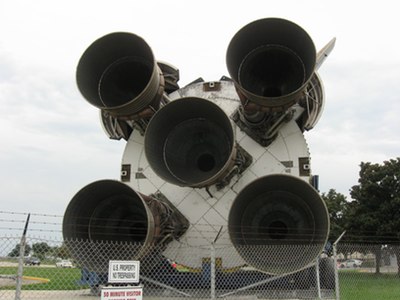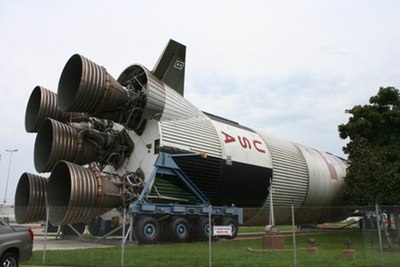Lonely giantby Dwayne A. Day
|
| This was a flight-ready piece of hardware, the last Saturn V first stage manufactured, and it apparently includes F-1 engines originally installed on the Apollo 15 and 16 S-ICs, as well as the last F-1 engine ever produced. |
The United States has done a better job of preserving its space history. All of the surviving space shuttles are either already in or headed for suitable permanent homes. Other flown American spacecraft are on display in various museums. And the three Saturn V rockets (although not all of them are flight objects) are protected and available to the public.
But there are some objects that deserve better treatment than they are getting. Recently the US Space and Rocket Center in Huntsville, Alabama announced their future plans, and fortunately one of the projects on their list includes refurbishing the exterior of the Skylab underwater trainer at the museum. Although the Space and Rocket Center has a great asset in the form of the Davidson Center for Space Exploration and their Saturn V rocket display, many of their exterior artifacts are in dire need of preservation.
Several hundred kilometers to the southwest sits another neglected piece of space history, a complete Saturn V S-IC first stage. It resides at the entrance to the Michoud Assembly Facility, which used to manufacture Saturn hardware like the S-IC and Space Shuttle External Tanks, but now doesn’t do much at all.
Officially designated S-IC-15, this was a flight-ready piece of hardware, the last Saturn V first stage manufactured, and it apparently includes F-1 engines originally installed on the Apollo 15 and 16 S-ICs, as well as the last F-1 engine ever produced. It was never officially designated for an Apollo mission, but most likely would have lofted Apollo 20 toward the Moon, if that mission had occurred. It was officially designated as a backup launcher for the Skylab Orbital Workshop. If, before flight, something had gone wrong with the first stage scheduled to lift Skylab, or if the first mission had failed completely (as it almost did) and the backup Skylab had to be launched, this first stage would have performed the mission. None of that happened—the backup Skylab currently resides in the National Air and Space Museum in Washington, DC—and so this expensive piece of hardware was also declared surplus.
 The Saturn V first stage on display outside the Michoud Assembly Facility in Louisiana. (credit: D. Day) |
This bit of neglected space history has endured humid Louisiana weather and several notable hurricanes, including Katrina. These photographs were taken less than one week before Hurricane Isaac bore down on the area. A perfunctory assessment indicates no obvious age-related damage, although the vehicle is clearly dirty and in desperate need of a cleaning as well as a paint job.
| But unless a rich benefactor steps up with some cash, the Saturn first stage will continue to be assaulted by the elements until it deteriorates to the point where it makes no sense other than to scrap it. |
But what S-IC-15 really needs is a new home, preferably indoors. It has been sitting outside for decades and should get indoors where its deterioration can be halted. But where? One obvious place would be the new visitor’s center a few kilometers from the gates of the Stennis Space Center in nearby Mississippi. S-IC stages were regularly barged from Michoud to Stennis during the Apollo era. But the Stennis visitor’s center is brand new, and adding a large annex is probably not economically or politically feasible at this time.
Unfortunately, no other options seem viable. KSC, Huntsville, and Houston all currently have complete Saturn V rockets. There are no other obvious East Coast locations for one. Billionaire Jeff Bezos recently expressed some interest in recovering one or more F-1 engines from the Apollo 11 first stage currently resting at the bottom of the Atlantic. But recovering such a heavy object from such a depth would be a major undertaking. If Bezos wants to collect some Apollo hardware, this S-IC-15 would be a great catch, and he could probably put it on display at a museum of his choosing if he offered to fund a proper restoration. But unless a rich benefactor steps up with some cash, the Saturn first stage will continue to be assaulted by the elements until it deteriorates to the point where it makes no sense other than to scrap it.
